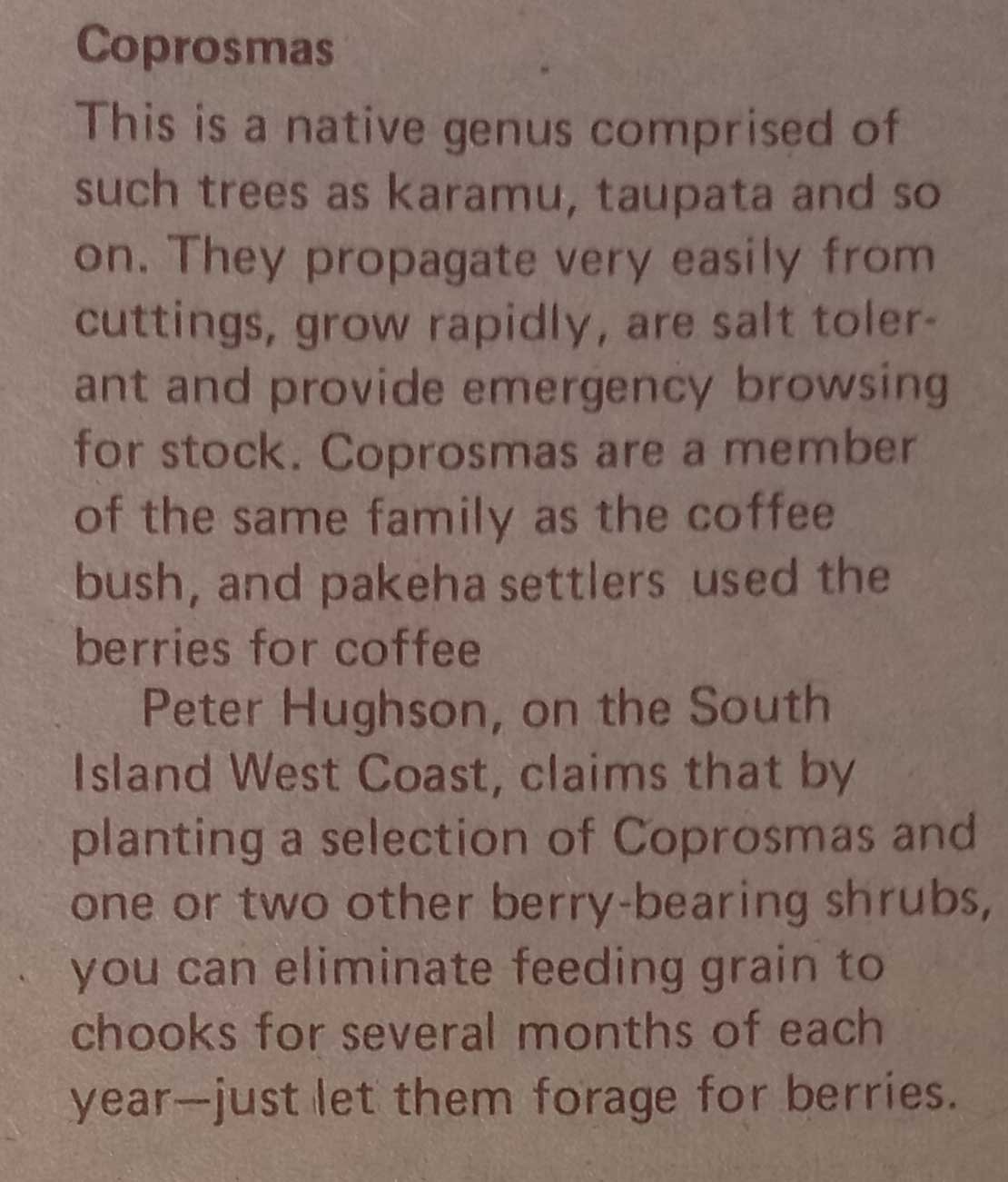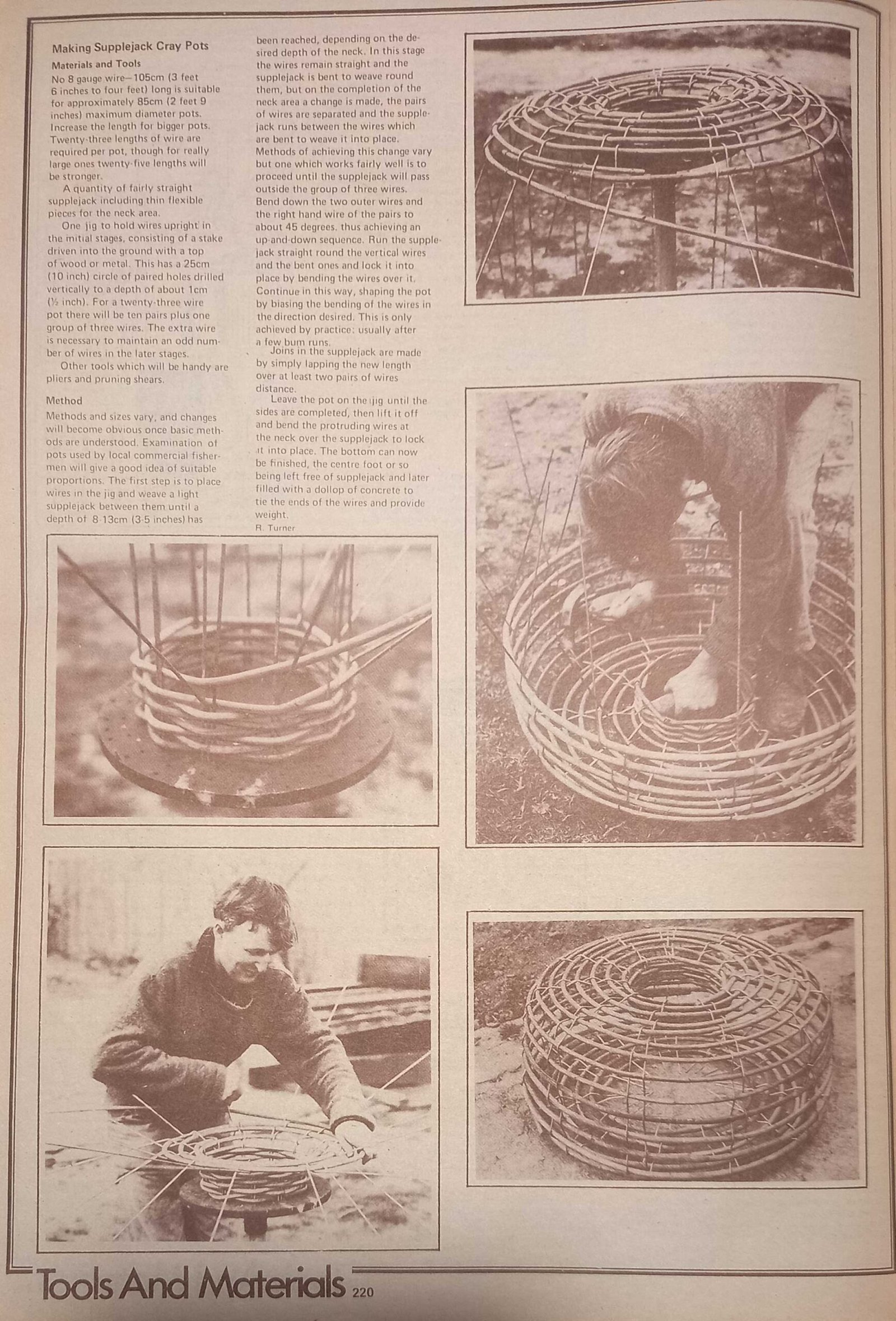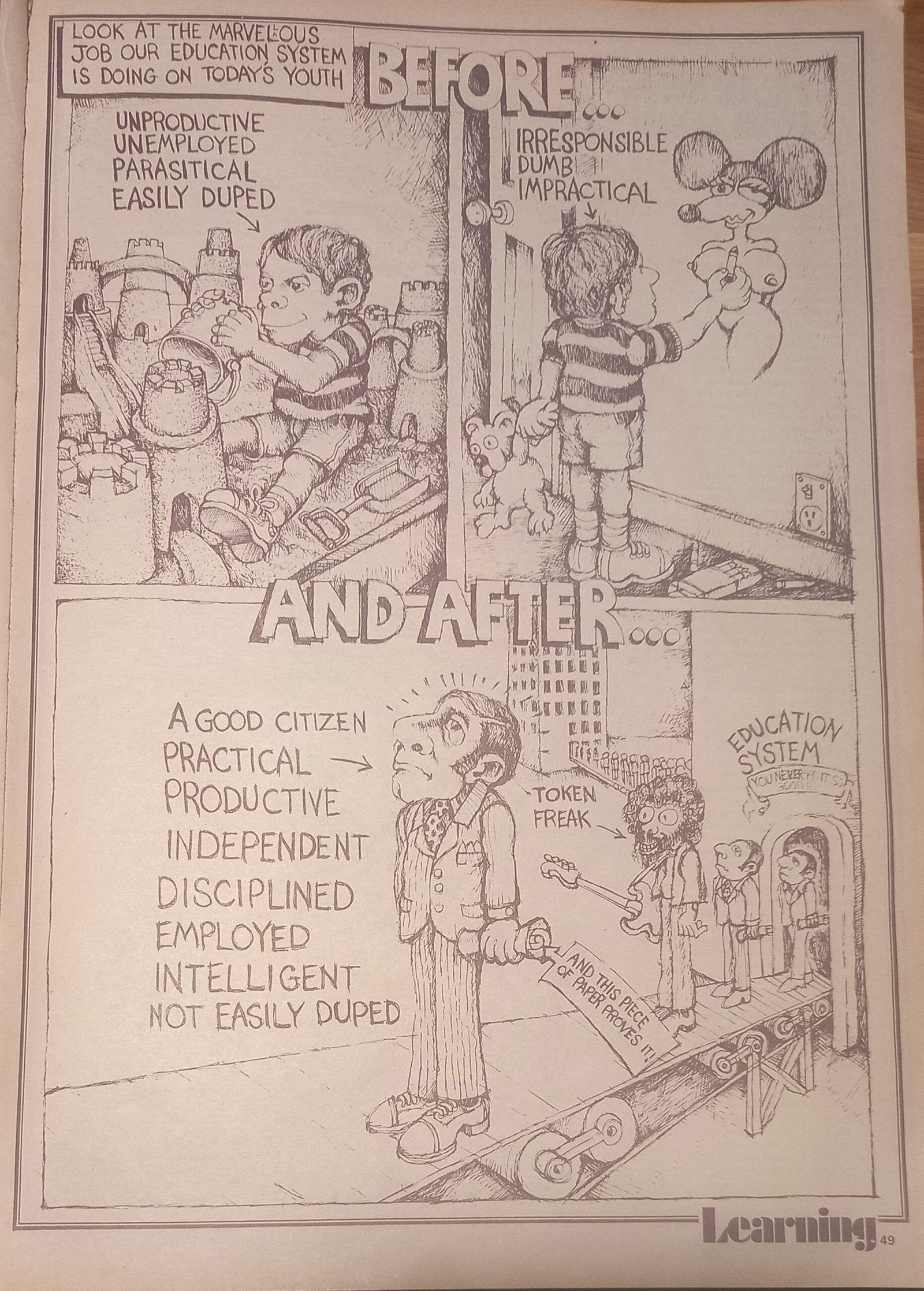Back in March I wrote this piece observing that my chickens really, really enjoyed eating New Zealand native coprosma fruit. It’s a fact I’m surprised isn’t more widely known.
That discovery led me on a research path: a Google search led me to a website, that sent me to a book called Permaculture Two – a classic reference book by Bill Mollison which happened to be sitting on my bookshelf.
That – in turn – referenced a book called The New Zealand Whole Earth Catalogue. Specifically the 1975, 2nd Edition.

And that’s where I got stuck. For months.
My local library didn’t have a copy, and neither did the larger but further-away Whangārei library. Other New Zealand libraries did have it so I submitted an inter-loan request – and never heard back. Queries on social media didn’t turn up what I was looking for either.
I began running a ‘saved search’ on TradeMe. This ingenious feature allows you to set an ongoing query for the stuff you want. When items matching your search criteria are listed, TradeMe lets you know.
I’ve been using this method for decades now, and it rarely fails me. All you need is a little patience. I find a lot of plants this way, and even it’s how Permaculture Two came to be sitting on my bookshelf in the first place!
For months I watched the First and Third editions come up for sale – usually at prices two or three times what I was willing to pay – but never the 2nd.
It was annoying. I have a few research topics in my life now where I’m stuck for one reason or another, and this felt like a really stupid brick wall to have.
What is The Whole Earth Catalogue?
There was a lot of waiting at this stage, so I’m going to take a moment to explain what these books actually are. You might already know, but despite the fact they have obviously had a hand in shaping at least my half my life’s core ideologies, I was blissfully unaware.
In 1968, a man named Stewart Brand launched a periodical in the US called The Whole Earth Catalog. In 2013, The Guardian described it as “the magnum opus of the entire counter culture”, while others go further and call it the book “that changed the world”. Steve Jobs famously described it as “Google in paperback form”.
Anna Weiner writing for The New Yorker probably summed it up best when she called it “a compendium of product listings, how-to diagrams, and educational ephemera intended for communards and other participants in the back-to-the-land movement.”
It looked to connect people to ideas, resources and information. There was a particular focus on the kinds of subjects you might associate with the counter-culture of the time; and which align remarkably well with my life now.

As you might guess, The New Zealand Whole Earth Catalogue was our own Kiwi spin off. Three editions were published in 1972, 1975, and 1977 by Alister Taylor and Dennis List. The above review comes from the First (1972) edition.
What is value?
After months of waiting, one morning in late May I got an email from TradeMe. The 2nd edition had been listed with a ‘buy now’ of $50, plus $15 postage.
This was the first time I’d seen it, but $65 was more than I wanted to pay. There might be two paragraphs in there that were relevant to my research and I didn’t value them that highly. Still, I put it on my watchlist and hoped they’d make a lowered fixed-price offer.
They didn’t. They relisted 3 times at exactly the same price. I kept adding it to my watchlist, but I was the only one.
And then in mid-June another listing turned up in my inbox. An auction with a $5 reserve. The book was even in better condition than the $50 copy! I made a bid immediately.
Seven days later, I had won. There had been no other watchers, let alone bidders. It left me thinking about value.
Yes, every other copy I’d seen to this point listed at the $50-90 mark. That seems to be the agreed value. But the only one that appears to have actually sold recently went to a lone-bidder for the starting price of $5.
It was to become a theme.
I seemed to be the only person hunting for New Zealand Whole Earth Catalogues at this particular moment in time. And I wasn’t willing to spend much more than about $30. I was willing to be patient, and I wasn’t too bothered about their physical condition.
I guess an impatient person might be more willing to spend the higher price for a faster answer, or for a better-condition copy.
But if there’s only one potential buyer, then the value pretty much becomes what they’re willing to pay. As long as someone is willing to sell it at that price, I suppose.
The 2nd New Zealand Whole Earth Catalogue arrives
After literally months of hunting for this thing, I was dying to find out what it had to say. It interrupted dinner the night it arrived as I kept going back to flick through while I was cooking.
There’s a lot of really interesting stuff in there. Almost everything that someone trying to live sustainably off the land in New Zealand might want to know seems to be crammed into those pages.
As I worked from the front to the back, I started wondering if maybe I wanted the First and Third editions as well?
Three pages from The 2nd New Zealand Whole Earth Catalogue. Click to expand in a new window.
It’s a peek at a slice of New Zealand history. I kept seeing familiar names, interesting articles, and every so often my jaw would drop to the floor from a statement that had aged particularly poorly.
It was a cracker read, and a useful reference book. It would be absolutely invaluable for people trying to live on the land in the 1970’s before the internet. But it didn’t seem to contain any information about Coprosma at all.
After an initial flick through where I read everything tangentially related to poultry or plants, I started ‘deeply skimming’ the larger and less-obviously related articles. Then over the next month I actually read every last page.
I couldn’t find any mention of any kind of poultry eating any kind of native plant at all!
Back to the hunt
Well, maybe Bill Mollison referenced the wrong version? He specifically states 1975 – the 2nd Edition – but these books are also filled with information on taking psychedelics and growing cannabis. An inaccurate reference was a possibility worth investigating before totally giving up.
Though it seemed unlikely. The First New Zealand Whole Earth Catalogue literally has “Summer ’72” written on the cover. However Permaculture Two was published in 1979, meaning all three versions of The New Zealand Whole Earth Catalogue pre-date it.
Because the First Edition was published in a rush, the follow up 2nd Edition included the index for the First. I marked the entries I thought might hold some hope in pencil, but nothing stood out. It felt like the Third might be the better bet.
It looked like I would be collecting the set after all.
So I kept my saved search running on TradeMe, and waited. It took another month for The First New Zealand Whole Earth Catalogue to show up again in mid-July with a $20 reserve. I made a bid immediately.
I wasn’t hugely hopeful – I had an idea of what was inside, and combined with the fact the publishing year is right there on the cover, it didn’t seem likely I’d find what I was looking for.
The First and Third New Zealand Whole Earth Catalogues
Seven days meandered by and once again I was the only bidder or watcher, winning the auction with my opening bid.
Before it had even arrived, the same trader listed The Third New Zealand Whole Earth Catalogue for $20. Another seven days, and guess what?
I managed to collect all three of these books for $45 + postage. They’re big books and I have a rural address, so roughly $30 each once that was accounted for.
That $50 copy of the 2nd Edition was still available to purchase – as well as a $90 copy of the Third Edition – when I deleted my saved search.
While I was waiting for my copy of the Third Edition to show up, I figured I better actually check the First Edition. I started flicking through. There was heaps more nudity in this one. And there – on page 147:

This… is a story for another day. Needless to say there was an excited happy dance, and a sense of smug satisfaction as I fell asleep that night.
It’s not the end of the Coprosma and chickens by any means. The first thing I did after finding it was to look up Peter Hughson and keep digging.
I’ve already made more progress than a Google-search brings – but really – that’s another blog.
After all this, it felt so good to find what was indeed two paragraphs I’d spent half the year (and the thick end of $100) looking for!
Completing the set
Earlier this week, I picked up The Third New Zealand Whole Earth Catalogue from the post office. This particular collection is now complete.
Steve Jobs’ rhetoric about these books being Google before Google might seem a little extreme – but seriously, that’s pretty much what I’d been thinking before I read his quote. The US version is acknowledged to have specifically influenced a lot of what went on to become the Silicon Valley we know today.
The books are interesting relics now, but if we lost the internet for some reason? I imagine they’d actually be quite helpful!
The Third Edition took a very close interest in home birthing. I was delighted to find an article by Gillian Painter – an Auckland-based herbalist whose entire catalogue of books I’d also tracked down and collected using a TradeMe saved search years ago.
Much of the technology, methods, and knowledge held within their covers are still relevant to my lifestyle. The books they review are frequently already sitting in my bookshelf. Some have been added to my saved searches on TradeMe to be collected in due course.
Part of a history
It’s not unusual to see a prediction and think ‘yep, that’s pretty much what happened’. The Third Edition dedicates 8 pages to the history of the Rio Tinto aluminium smelter in Bluff. The same smelter that is still holding the nation hostage and polluting the environment.
Of course, there’s also predictions that didn’t come to fruition. But it’s still kind of impressive how much they did get right. I’m not sure I could be that accurate about the next 50 years myself.
As I flicked through the pages, I couldn’t help but think about my mother – 16 when the first one was published – flicking through them too. I’ll probably never know for certain, but I have one of my funny feelings she browsed through these pages herself at some point.
It’s all echoes. For better or worse, the beginnings of so many things are so clearly sitting within these volumes. The Whole Earth Catalogues are a part of the same history that I’m now part of writing this blog, 50 years later.
By writing and publishing my stories, adventures, and experiments on the internet for you to read each week, I’ve come to realise I’m continuing the things The Whole Earth Catalogue began.
And by reading it – my dearest reader – so are you.









That was a fascinating process, and really interesting to see some of the pages. I know more about hue now, thank you!
(Love TM saved searches – I have a few dozen quietly chugging away and occasionally coming up Millhouse.)
Gosh, the thrill when they come up Millhouse huh? I wish I could have included more, but it’s still within its copyright period so I wanted to keep well within fair use. Worth a flick through if you ever come across one though.
I remember poring over the Whole Earth Catalogue with my best friend in 1996 when we were sixteen – it led to us drying banana peels behind the radiators at school but never having the courage to smoke them!
Ahahhaha, page 169 of the First Edition: “Mellow Yellow And Other Smokes. Smoke the dried scapings from the inside of banana skins. Three or four joints may give you a mild high. Some people hard up for a joint have also tried smoking petunia or tomato leaves. These plants are vaguely related to tobacco, datura, etc.” You probably would have been better off hunting out some mushies in Wellington – some of these tips are super marginal in terms of human health 😅